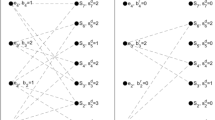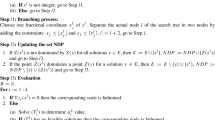Abstract
This paper deals with the Bi-Objective Set Covering Problem, which is a generalization of the well-known Set Covering Problem. The proposed approach is a two-phase heuristic method which has the particularity to be a constructive method using the primal-dual Lagrangian relaxation to solve single objective Set Covering problems. The results show that this algorithm finds several potentially supported and unsupported solutions. A comparison with an exact method (up to a medium size), shows that many Pareto-optimal solutions are retrieved and that the other solutions are well spread and close to the optimal ones. Moreover, the method developed compares favorably with the Pareto Memetic Algorithm proposed by Jaszkiewicz.
Similar content being viewed by others
References
Balas, E., and A. Ho. (1980). “Set Covering Using Cutting Planes, Heuristics and Subgradient Optimisation: A Computational Study.” Mathematical Programming Study, 12, 37–60.
Beasley, J.E. (1987). “An Algorithm for Set Covering Problem.” European Journal of Operational Research 31, 85–93.
Caprara, A., M. Fischetti, and P. Toth. (1999). “A Heuristic Method for the Set Covering Problems.” OR 47, 730–743.
Ceria, S., P. Nobili, and A. Sassano. (1998). “A Lagrangian-Based Heuristic for Large-Scale Set Covering Problems.” Mathematical Programming, 81, 215–228.
Chvátal, V. (1979). “A Greedy Heuristic for the Set Covering Problem.” Mathematics of Operations Research 4(3), 233–235.
Cordone, R., F. Ferrandi, D. Sciuto, and R. Wolfler Calvo. (2001). “An Efficient Heuristic Approach to Solve the Unate Covering Problem.” IEEE Transactions on Computer-Aided Design of Integrated Circuits and Systems 20(12), 1377–1388.
Daskin, M.S. and E.H. Stren. (1981). “A Hierarchical Objective Set Covering Model for Emergency Medical Service Vehicle Deployment.” Transportation Science, 15(2), 137–152.
Ehrgott, M. and X. Gandibleux. (2000). “A Survey and Annoted Bibliography of Multiobjective Combinatorial Optimization.” OR Spektrum, 22, 425–460.
Gandibleux, X. Personal communication.
Gandibleux, X., D. Vancoppenolle, and D. Tuyttens. (1998). “A First Making Use of GRASP for Solving MOCO Problems.” In Proceeding of the 14th International Conference on Multiple Criteria Decision-Making pp. 8–12, Charlottesville, USA.
Jaszkiewicz, A. (2001). “A Comparative Study of Multiple-Objective Metaheuristics on the Bi-Objective Set Covering Problem and the Pareto Memetic Algorithm.” Working Paper RA-003/01, Institute of Computing Science, Poznań University of Technology ul.Piotrowo 3a,60-965 Poznań, Poland.
Jaszkiewicz, A. (2003). “Do Multiple Objective Metaheuristics Deliver on their Promises? A Computational Experiment on the Set Covering Problem.” IEEE Transactions on Evolutionary Computation, 7(2), 133–143.
Liu, Y.H. (1993). “A Heuristic Algorithm for the Multi-Criteria Set-Covering Problems.” Mathematic Letter 6(3), 21–23.
MCDM society. (2001). http://www.terry.uga.edu/mcdm.
Nemhauser, G.L. and L.A. Wolsey. (1988). Integer and Combinatorial Optimization. John Wiley and Sons, New York.
Steuer, R.E., L.R. Gardiner, and J. Gray. (1996). “A Bibliographic Survey of the Activities and International Nature of Multiple Criteria Decision Making.” Journal of Multi-Criteria Decision Analysis, 5, 195–217.
Tuyttens, D., J. Teghem, PH. Fortemps, and K. Van Nieuwenhuyze. (2000). “Performance of the Mosa Method for the Bicriteria Assignment Problem.” Journal of Heuristics 6, 295–310.
Visee, M., J. Teghem, M. Pirlot, and E.L. Ulungu. (1998). “Two-Phases Method and Branch and Bound Procedures to Solve the Bi-Objective Knapsack Problem.” Journal of Global Optimization, 12, 139–155.
Zitzler, E. (1999). Evolutionary Algorithms for Multiobjective Optimization: Methods and Applications. PhD thesis, Swiss Federal Institute of Technology (ETH), Zurich, Switzerland.
Author information
Authors and Affiliations
Corresponding author
Rights and permissions
About this article
Cite this article
Prins, C., Prodhon, C. & Calvo, R.W. Two-phase method and Lagrangian relaxation to solve the Bi-Objective Set Covering Problem. Ann Oper Res 147, 23–41 (2006). https://doi.org/10.1007/s10479-006-0060-5
Published:
Issue Date:
DOI: https://doi.org/10.1007/s10479-006-0060-5




